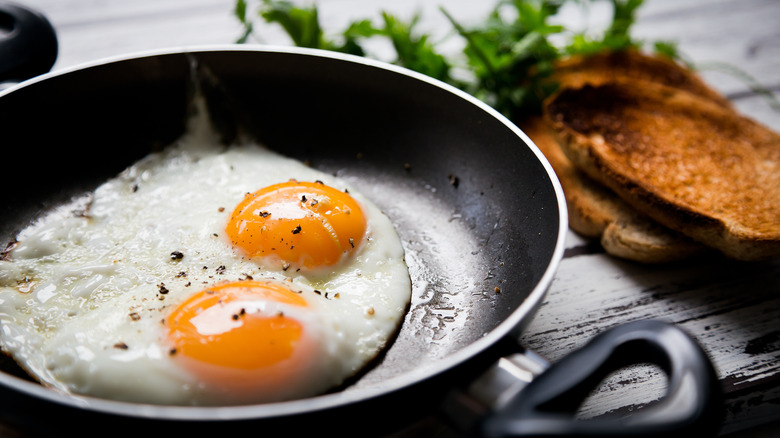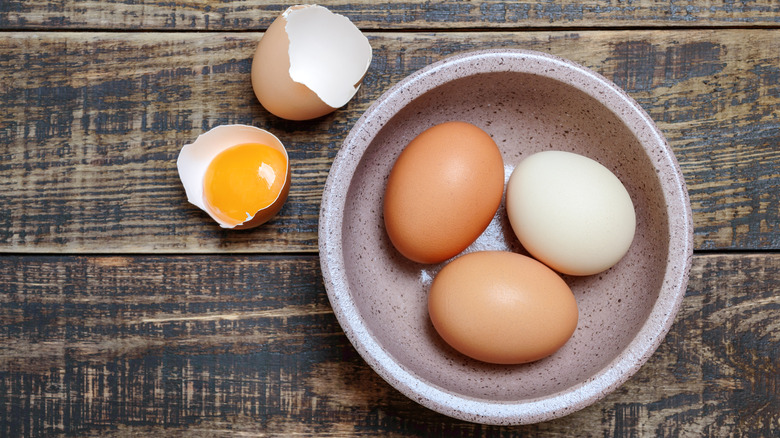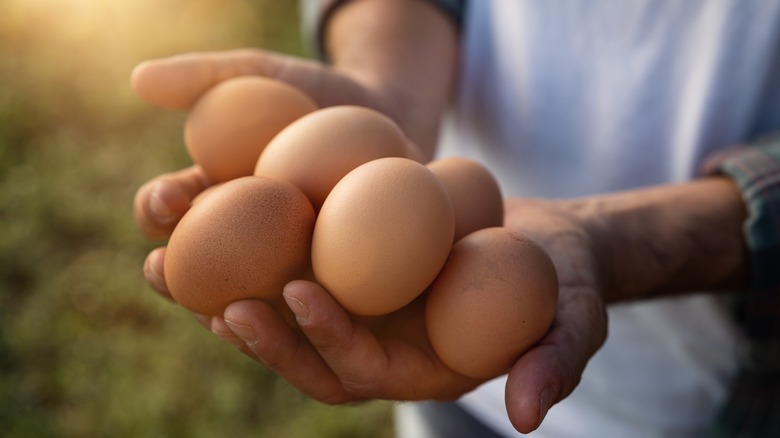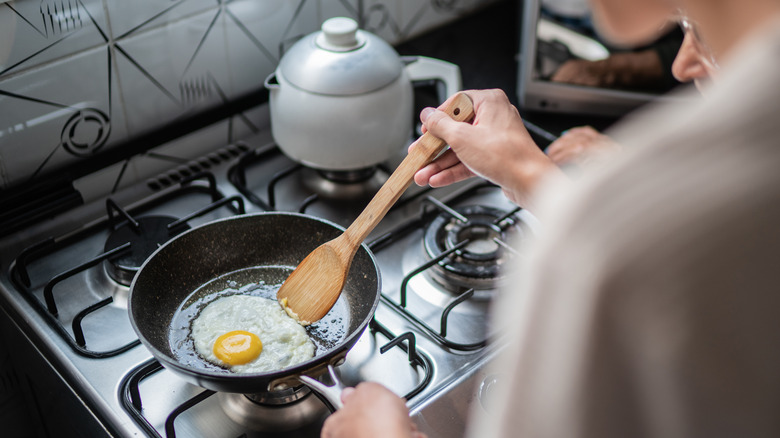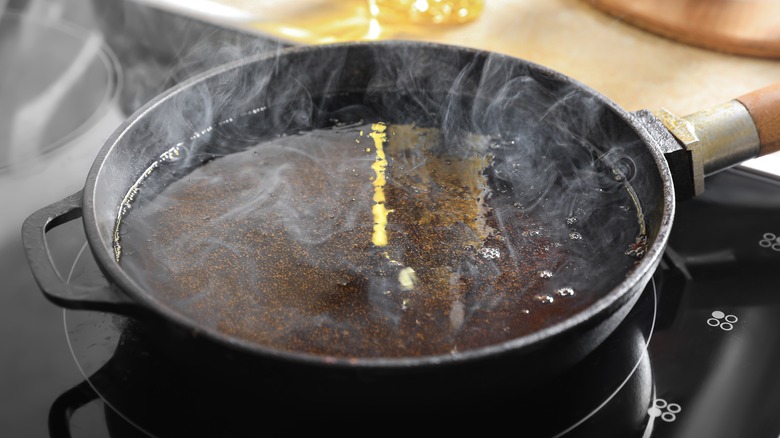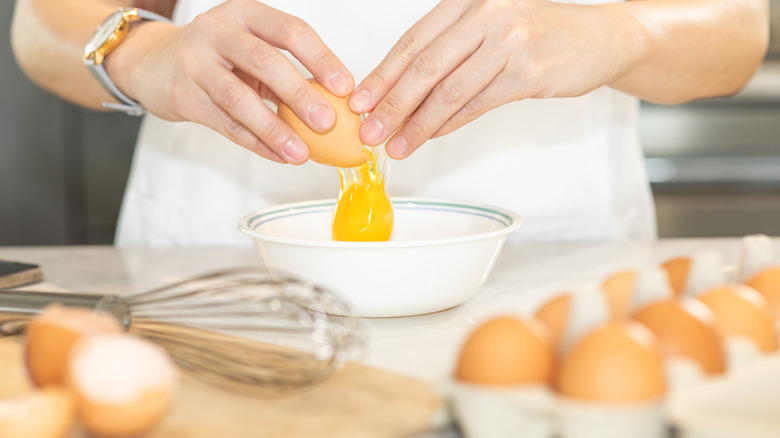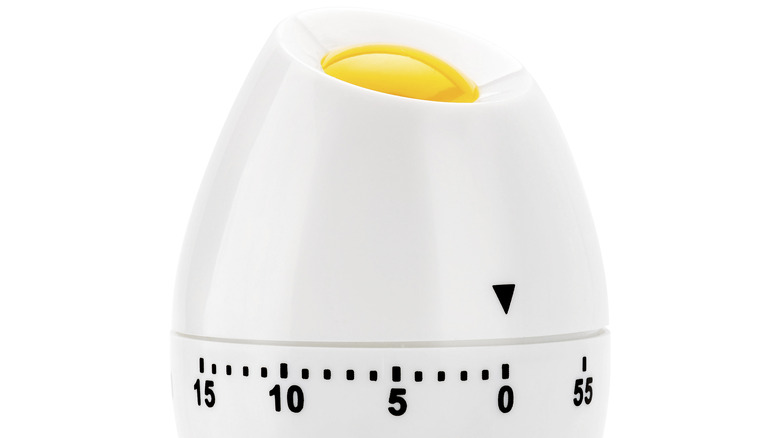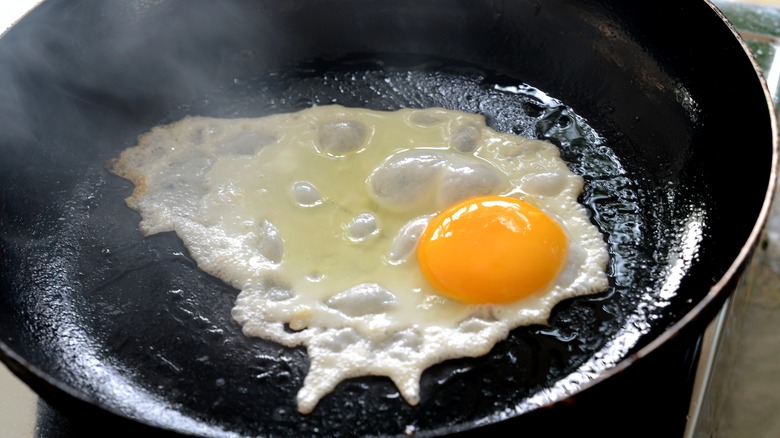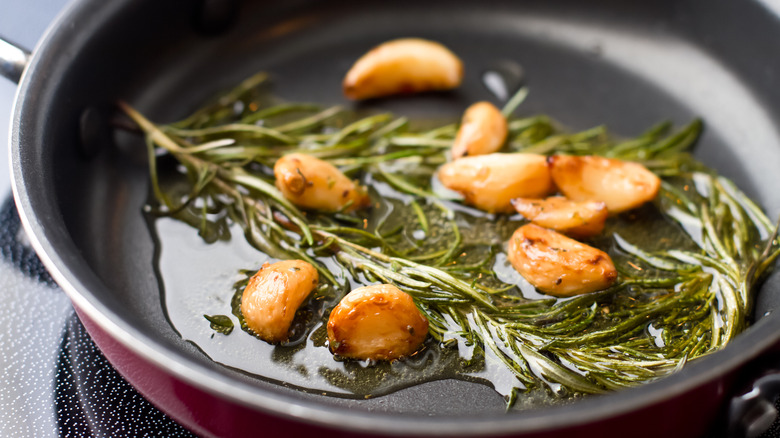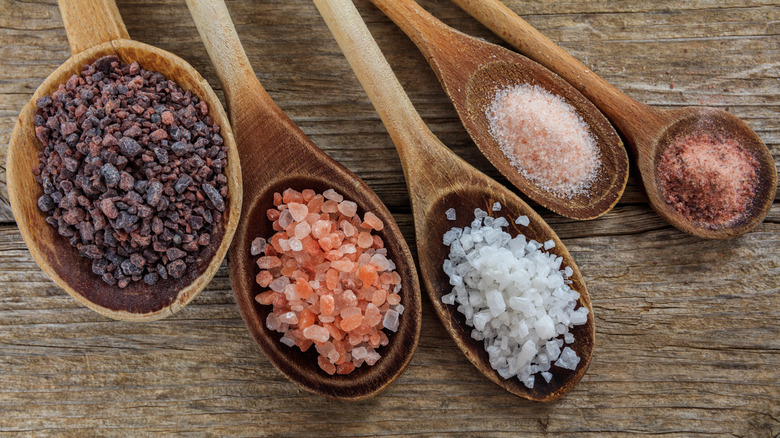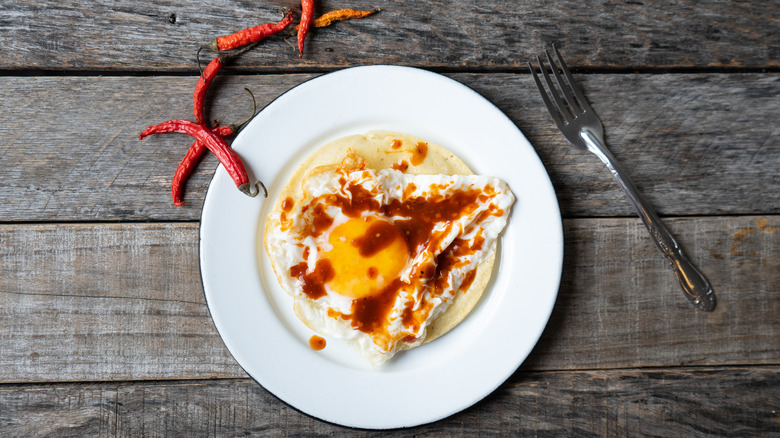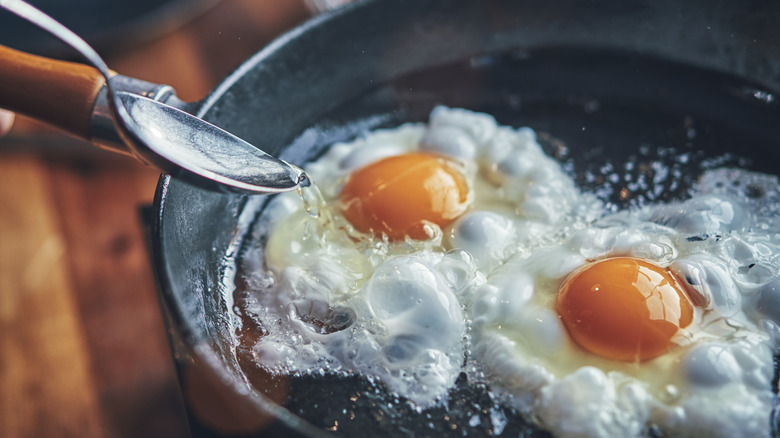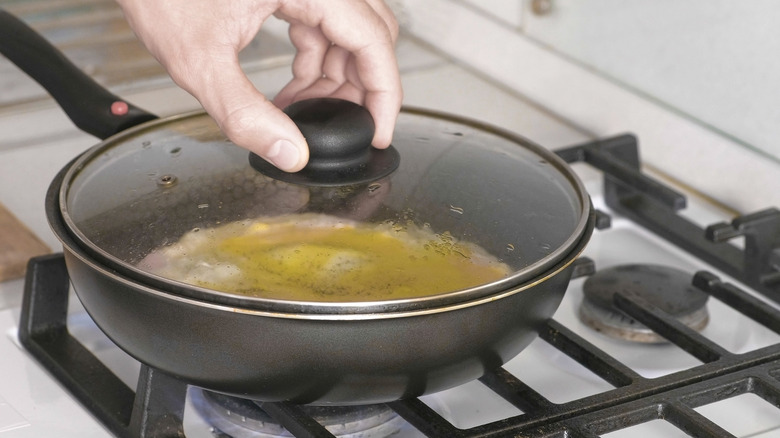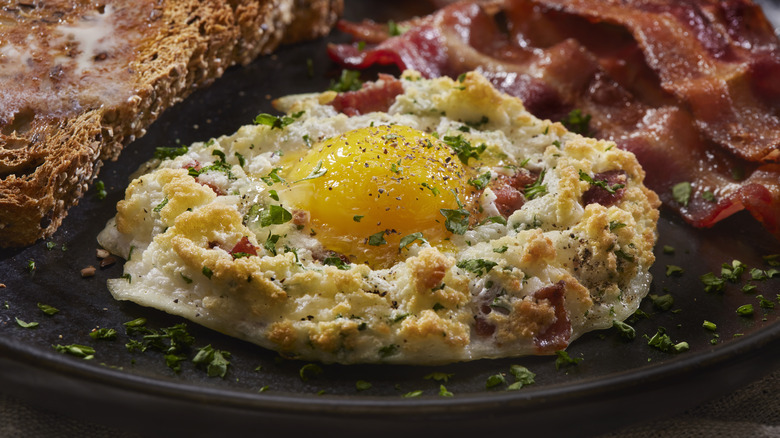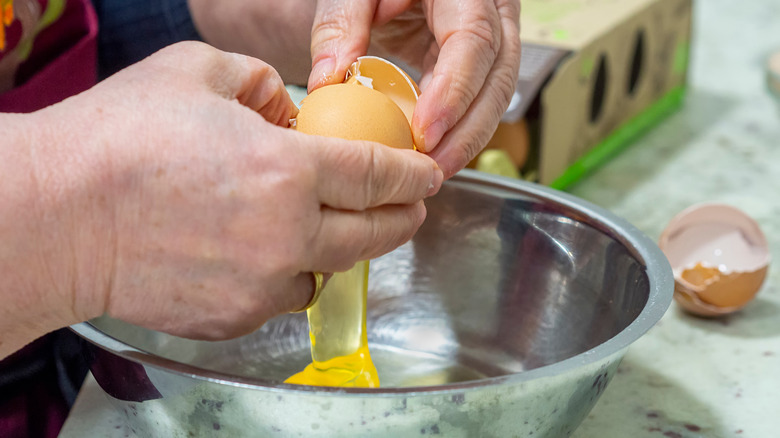14 Simple Hacks That Will Make Your Fried Eggs Even Tastier
A perfect fried egg is one of life's simple pleasures. So simple, in fact, that you may not think twice about it. Delve into the process of frying up an egg, though, and you will find a surprising number of places where things can go sideways. Luckily, there are steps you can take not just to avoid these missteps, but to ensure that your eggs come out perfectly cooked every time.
Unlike with scrambled eggs or omelets, the trick with a fried egg is to keep the yolk and the whites separate while they cook. The yolk should also remain whole. There are four different fried egg styles, depending on how you like your yolk: over-well, over-medium, over-easy (if the egg is cooked on both sides), and sunny-side-up (if the egg is only cooked on one side). An over-well yolk will be completely firm and an over-medium yolk will have some give to it. But over-easy and sunny-side-up eggs will have runny yolks. In all cases, the whites should be cooked through, but not overdone — as they can become brittle or rubbery.
No matter which type of fried egg you prefer, getting a few simple techniques down will ensure you're getting the most out of this breakfast staple. We've put together some of the best hacks here.
1. Bring the eggs to room temperature first
Frying an egg properly is all about precision. This is particularly the case with chicken eggs, which are smaller in size than duck or ostrich eggs. Cooking chicken eggs is done in a flash. The difference between a shimmering masterpiece and a hub of rubber can happen in seconds. Give yourself a leg up by letting your eggs reach room temperature before you begin.
If an egg goes into the pan cold, it's a long journey to get from raw to cooked. The chance that your whites and yolks won't both set at the same time is greater. Cold eggs also potentially lengthen the cooking time, which will likely yield unsatisfactory results. Unfortunately, if your eggs are coming straight out of the refrigerator, it can take a long time to get them tempered. But as long as you don't leave them out for more than two hours, this is a perfectly safe method, according to the U.S. Food and Drug Administration.
If you'd rather not wait, though, there's a hack that can get it done quickly. Warm water — not hot, or the eggs might cook — can raise the temperature of your eggs in just a few minutes. Either soak them in a bowl or put them under a stream of running warm water. Give the shells a touch check regularly, and when the chill is gone and they start to feel a bit warm, they're ready to go.
2. Buy fresh, high quality eggs
No matter what you're using them for, fresher is better when it comes to eggs. Unfortunately, most of us don't have a coop of hens at the ready, so we're required to sort through the countless brands, labels, and colors of eggs available at the grocery store. It can be overwhelming to know how to find the best eggs for frying. But with a little bit of knowledge, you can ensure you're making the right choice.
There is a ton of terminology on egg cartons. While some of it is helpful in determining what to purchase, a lot of it is not. Egg freshness and shell integrity are given a letter grade, with AA being the best and A the next best. If you want to make sure your eggs are from hens that are given the best treatment, look for phrases like organic, certified humane, cage-free, free range, or pasture-raised on the carton. These first two terms are arguably the most important and the most regulated, so a combination gives you the best guarantee that your eggs will be high quality.
Despite some myths to the contrary, shell color has nothing to do with egg taste or quality. It's determined genetically and differs from hen to hen.
3. Choose the right pan
One key element to successfully frying an egg and having it look presentable is using the right pan. Eggs are delicate and notorious for sticking to cookware. The easiest way to prevent a stuck-on, broken, burnt disaster is to use a pan with a surface that will let them cleanly release. What makes a pan nonstick is not the base material itself, but its coating. There are several types of nonstick coatings, each with its own pros and cons when it comes to frying eggs.
Teflon is likely the one you're most familiar with. Also known as polytetrafluoroethylene or PTFE, this substance works like a charm when it comes to practicality, but there have been concerns over the years as to potential health issues related to its use. Further study concluded that a specific chemical called PFOA was to blame, and since 2013 it's been banned. PTFE pans are the most affordable, generally, of all the nonstick cookware, and work extremely well with fried eggs.
Ceramic is a safe and popular nonstick option, although the coating won't last as long as Teflon as it's somewhat less durable. Well-seasoned cast iron is another option, which boasts nearly endless durability, though you must take proper care of it to keep the surface functional. Carbon steel is another useful, yet lesser-known, option.
4. Use a flavorful fat
You've got the eggs, you've got the pan, and now there's one crucial item left — the fat. Even if you're using the most advanced nonstick pan in the world, you need a little bit of fat to give your egg sizzle and flavor. Neutral cooking oil or butter (or a combination of the two) are some common options when you're ready to heat up your pan. But if you want to give your crispy fried eggs a major boost, you should use the most flavorful fat you can find.
No breakfast is complete without bacon, so using bacon fat to fry your eggs is a no-brainer. You'll get the savory, smoky quality of bacon plus the richness of a fried egg in one. Other animal fats, like duck fat or beef tallow, can add their own unique meatiness and opulence to your eggs. In the less carnivorous department, browning your butter first gives your fried eggs a sweet, nutty character. Ghee (or clarified butter) allows you to use hotter temperatures while cooking, because these fats don't burn as easily, giving you more flexibility during the cooking process. High-heat-tolerant oils, such as avocado and coconut oil, can also add their own unique flavors to fried eggs.
5. Slide them slowly and gently into the pan from a bowl
No matter how skilled you might think you are at cracking an egg, it never hurts to give yourself room for error. Even if you have perfected your technique, there's always a chance that a little fleck of the shell can split off, embed itself into the flesh of the egg as it cooks, and ruin an otherwise perfect bite with its brittle, sharp grit. To avoid this, always crack your eggs into a separate vessel, never straight into the pan. A bowl or measuring cup will do. Then, check for any stray bits of the shell before you add the egg to the pan.
When you are confident it's shell-free — and your pan is fired up and ready to go — the next step for a perfect egg is to add it slowly and gently onto the preheated surface. A careful, deliberate motion will better allow you to control the shape and size of the egg. Cracking it right from the shell or tossing it in haphazardly can let the whites spread unevenly, creating edges that are too thin, and likely to burn before the rest of the egg is cooked. Not to mention, an untidy egg lacks aesthetic polish. So treat your egg with care and consideration as it hits the heat.
6. Set a timer
One of the greatest things about fried eggs is that once you start cooking, they're ready to eat almost instantaneously. The average egg takes between 3 and 4 minutes to cook, more or less depending on size and doneness level. When you've got a craving, even if your eggs are refrigerated, you can temper them, fry them up, and have a plate ready to eat in about ten minutes.
This advantage can be a curse if you're not paying attention. Especially if you like soft whites and a runny yolk, a few extra seconds of cooking can ruin your perfect breakfast. Ideally, you should be keeping an eye on your pan and adjusting the position and heat level, but things happen and distractions are inevitable.
That's why it makes sense to always — no matter how confident you are — set a timer. There's a reason egg timers are a thing — precision is crucial to get a perfect egg, whether you're boiling, poaching, or frying. Keeping one on your kitchen counter is a good reminder to always set one, although, of course, a smartphone works just as well.
7. Watch and adjust the heat level as you fry
Since a fried egg takes only a few minutes to cook, it's crucial to keep an eye on the heat. Depending on the size of your egg, and the shape it's taken in the pan, the whites can vary greatly in how long they take to set. If they've spread out a lot, you want to make extra sure the heat isn't too high or they'll crisp up and become virtually inedible. But if you're paying close attention and sometimes lowering the heat, you can avert disaster.
You don't want the heat to be too low, though, or the bottom of the egg will cook much faster than the top. This is a particular issue if you're going for a sunny-side-up egg. Keep one hand on the dial, and the other on the pan, moving it on and off the heat as you see fit, and you should be able to get every part of the egg cooked to your liking. It may take some trial and error to find the combination of heat levels that will lead to the egg of your dreams, but it's worth experimenting to find that perfect balance.
8. Grab some fresh herbs and fry them
A sprinkle of fresh chopped parsley or chives is a classic egg dish garnish, adding a pop of vibrant green and a touch of freshness. But there's a way to incorporate herbs that brings a bigger punch of flavor to your fried eggs, and that's flash-frying them first. When properly done, the herbs will retain their bright green color, and they'll impart a deeper, more robust taste.
The method is simple. Since you're already frying, you can use the same pan and the same fat. Once your egg is fried, keep the heat on and toss in your herbs. Keep an eye on them, flipping them if necessary, and after just a few seconds they should be nice and crisped up but still green. If they've gone brown, they've cooked too long. Once removed from the pan, they can be left whole, or chopped up and scattered over the top of your fried eggs.
Hearty herbs such as rosemary and thyme are well-suited to frying and become wonderfully aromatic when heated. Because the cooking time is so short, this method works just as well with more delicate herbs, too, like tarragon and basil.
9. Season with a special salt
Perhaps the number one easiest way to boost the flavor of a fried egg is to elevate your salt game. For a purist who only wants to taste the egg as unadorned as possible, a sprinkling of kosher or sea salt is the perfect simple seasoning. But if you want to go the extra mile, there are countless specialty salts that will add a new flavor dimension to the humble fried egg.
Himalayan black salt is a fun one to reach for, as it has a distinctive egg-like flavor itself. Vegans can use it to replicate the taste of eggs in plant-based dishes, but if you add it on top of eggs, it magnifies their natural character. Throw some smoked salt on your egg to bring the whiff of cooking over a campfire to your breakfast. Gourmet flavored salts come in all varieties, like truffle salt, which adds a luxuriously intense pop of umami when used to season a fried egg.
10. Spice them up
A lot of folks toss hot sauce on top of their fried eggs after they've been cooked and plated, but there are other ways to incorporate spicy heat into the dish. Start with the fat — no matter if you're using butter, oil, bacon fat, or some combination of these, you can infuse spice into the substance before your egg starts sizzling. This can be in the form of chopped fresh chilies, whole-dried chilies, or red chile flakes. This way your egg is soaking in all that spice from the get-go.
You can use these same fiery ingredients to top your egg for an extra spice boost, too. Ground cayenne pepper is good for pure heat, while a chili powder blend will give you a more complex spicy boost. Chili oil is the perfect ingredient to have on hand, as you can fry your eggs in it and use it as a garnish.
11. Baste the eggs while they fry
This hack is invaluable for sunny-side-up eggs, to make sure the top of the egg is cooked as well as the bottom. With the sunny side up, you don't get the benefit of the flip — since the top side never touches the pan, you run the risk of leaving it underdone. To combat this, all you need is a spoon.
The technique is simple. As the eggs are comfortably sizzling away, tilt the pan slightly so that the fat pools to one side. Dip your spoon in and pour it over the top of the eggs, making sure you cover the yolks and the whites. The heat from the fat will gently cook the egg underneath, while still allowing it to maintain its bright sunny side up character. It'll also add more flavor, particularly if you're using a cooking fat with a strong taste. Repeat this basting motion until the top of your eggs is set and cooked as well as you like.
12. Cover with a lid for even cooking
If you're not using enough fat to baste your eggs, there's another hack that can ensure your top is cooked through. Covering the egg while it cooks traps in steam, which circulates along the top of the egg, heating it evenly and more thoroughly than if it were left uncovered. Since this technique causes the top to cook faster than it normally would, you're more likely to end up with an egg that's evenly done from top to bottom.
If your skillet or frying pan doesn't have a lid, don't worry. You don't have to have an airtight seal for it to work. Anything placed above the top of the egg will help — a heatproof plate or inverted bowl, baking sheet, or layer of aluminum foil folded to fit over the pan. As long as you're keeping the warm air circulating around the top of the egg, you (and your egg) are golden.
13. Add a crunchy ingredient for texture
One reason to opt for a fried egg, instead of a scrambled or poached one, is that you get more texture. While those other preparation methods will leave you with eggs that are fluffy or soft, a fried egg can deliver a little crispiness around the edges which contrasts nicely with the rich yolk and silky whites. But sometimes that little bit of crunch just isn't enough. Luckily, there are some simple ingredients you can use to bump up the crispiness even more.
Bacon and eggs go together well, of course. Instead of serving bacon strips on the side, you make them a part of your fried egg. Cook them first, then chop or crumble them up. You can add these bacon bits to the egg white while it's frying so they meld together, giving you a meaty, savory crunch with each bite. Or you can pepper them over the top as a crispy garnish. If you don't want to go the meat route, you can use toasted breadcrumbs, sesame seeds, or pepitas to achieve a similar texture.
14. Crack your eggs like a pro
Sadly, there's no secret magic technique for cracking an egg perfectly every time. Every egg is slightly different, with thinner or thicker shells. Some eggs will cooperate when you try to break them open cleanly, and some just won't. That said, you can maximize your chances of success by using one simple hack — using a flat surface. This is one of the best ways to keep the yolk intact when frying eggs.
While it may seem more intuitive to crack an egg on a sharp corner or jutting lip, the pressure of hitting the shell against an object like that actually makes it more likely that it will splinter into pieces. However, if you tap the egg against a hard flat surface, such as a countertop, there's no inward impact on the shell, and it's more likely to form one clean crack. You can then gently pull the two halves apart, as long as you're careful not to break the yolk as you do so.
